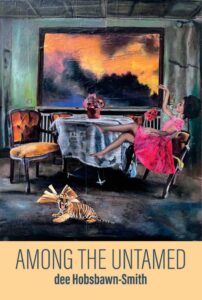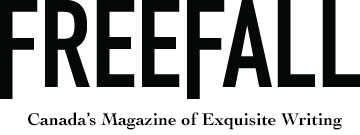By Mary Vlooswyk
Among the Untamed
by dee Hobsbawn-Smith
Frontenac House Poetry (2023)
Among the Untamed by dee Hobsbawn-Smith is an exploration of how to be a woman in today’s world. Through her poetry, Hobsbawn-Smith tackles the many forms of violence against women “Mourning Mothers,” aging “Faith-writing in the dark,” accepting one’s body “Jeanne Dark comes of age on the prairie,” as well as the subtleties of female friendship “Sharing mason jars.” She takes the reader on a journey from farm life “Jeanne Dark contemplates the prairie sky” to the city “The Only,” back to the farm “Where Jeanne Dark comes from.”
Hobsbawn-Smith’s writing is open, honest, raw lyrical poetry that tends to favour couplets. She also has a couple of haibun in the compilation. The poetry reaches out to the wider world—those we know in this life and those who are deeper in our blood. In “Jeanne Dark comes of age on the prairie,” the speaker of the poem notices herself noticing other women in her life. Her mother, aunt, grandmother, and sister: “that her I’ve grown into and barely recognize / in the mirror, that her, a composite of all the women / who’ve come before me.” The speaker of the poem connects back to the world and finds a sense of her place in it.
dee Hobsbawn-Smith has the reader enter her poetry with “Jeanne Dark contemplates the prairie sky.” It is a brooding contemplation of ancestry, especially the women who have come before her in her own family. The poem resonates a subtle portrayal of anger. The final line of the poem is startling in its direct naming of the anger that has been beneath the surface of the poem. Now that the anger is named, there is space for joy, space to move on. How many women live their lives with an anger below the surface that remains unnamed?
“Jeanne Dark leaves the sheltered corner” has a wistful sense of the speaker of the poem wanting to be an activist, to make a difference in the world. Early in the poem she states the desire “to give voice to the speechless.” The poem portrays the speaker’s interactions with her husband and sons, but the final two lines have the most impact:
“She speaks the names of all those lost / women and girls, none forgotten.”
“Where stones gather” is a beautiful tribute to a dog. “For months, you dream the same dream—a walk / across frozen fields behind your November-coloured dog.”
I think about all the times I walk in an urban park and see coyotes in the distance, hear their howls at night, see their tracks in the snow on the lawn in the morning. I think about all my neighbours who have dogs that roam off leash. This poem is written with love and no nonsense regarding the wild and domestic coming together.
Slowly, as the poems progress through the book, the speaker of the poems lets the reader see the world as she sees it. The reader is given insight to her sense of helplessness with some of society’s problems, such as homelessness in “Jeanne Dark’s fear of bridges.” The reader is given hints that the poet is acting in ways to address her concerns, such as through serving meals in a shelter: “saw the girl again still shadowed by men.” The speaker of the poem expresses her doubt about how she is dealing with her concerns.
Throughout the book there is an undertone of feminist bias—a simmering anger that may erupt at any moment, in any poem. There’s a sense of questioning the way things are in the world, and a frustration that there are not any clear-cut answers. “Marilyn (un)dressed” channels Marilyn Monroe. The speaker of the poem gives a detailed recollection of Marilyn then matter-of-factly gets the point across: “She never lived past full blown rose.”
“The Only” shares the impact of a teenage memory from downtown Vancouver’s East side and a return visit ten years later. Despite the horror of the memory, Hobsbawn-Smith offers a delicate respect to the young woman abandoned on the street.
“Quotidian, female,” “Sty,” and “Consider the bus driver” hold vivid imagery of violence against women. “Quotidian, female” is shocking with wave after wave of violence and entitlement of those who enact the violence. There is wave after wave of nausea. The final line of the poem, “More before, more since, so many. Too many” is succinct and truthful but almost feels trite after the bombardment the reader has just witnessed. “Jeanne Dark enlists an army” is a welcome relief after three very disturbing poems. This poem offers the spark of hope, enough for the reader to continue reading.
Among the Untamed shows how quickly beauty can be transformed into something else. dee Hobsbawn-Smith’s poetry portrays how intimate experience can also be viewed globally. Among the Untamed challenges readers to not look away from topics that make one uncomfortable. Hobsbawn-Smith faces difficult issues head on. She adds her voice to the collective wisdom of women.
Mary Vlooswyk is a multimedia artist whose favourite colour is orange. Her writing has been shortlisted in contests, and published locally and internationally. Her poem, “An Origin Story,” recently won Gold at the Alberta Magazine Awards. Shanti Arts published her charcoal drawing, Surrender to the Wind, in March, 2023. She enjoys running and any activity that takes her outdoors. You may hear her play cello where she lives with her husband, on the edge of beautiful Fish Creek Park in Calgary, AB.
